Gain a Competitive Advantage with Enterprise Knowledge Management
In today's fast-paced digital landscape, businesses are generating and consuming vast amounts of information and knowledge at an unprecedented rate....
3 min read
Innovatia : Jun 6, 2023 3:39:48 PM

Storage is cheap, search functions work well, and content creation has never been easier. Or are they? Your teams keep creating content and storing it in their individual repositories believing that people will find it when needed. And when someone needs information, they either do not find it or find swarms of irrelevant or similar content and sometimes even inaccurate information.
Welcome to ROT content. ROT stands for Redundant, Outdated, and Trivial content.
Understanding ROT – the triple threat
Redundant information is the same or similar information that is accessible in many versions, places, or channels. This may be unintentional, or duplicates were created because the original content was difficult to find. Care and consideration must be made in creating content and a formal approval and implementation process is recommended to avoid redundant information.
Outdated information is information that is no longer correct or has been replaced by a newer version. Information becomes outdated for several reasons. Time-sensitive information becomes obsolete after its deadline passes. A user guide becomes outdated when that product is updated or retired. Price charts, spec sheets, and product comparisons become outdated over a period. Offers that expired, webinars that are no longer relevant, and contact information—phone number, email address, or social media handles—that no longer exist, are common examples of outdated content. Outdated information is easy to overlook, as it can get on the To-Do List but is not time-sensitive nor a high priority and consequently does not get addressed.
Trivial information can be an area of disagreement. What one team considers trivial, another team may consider important. A broad guidance to decide if a piece of content is trivial is to consider the business value it holds. Most of the correspondence, presentations, and other ephemera from our work carry only temporary value.
Such content may not hold the value of business-critical records and may be removed after a minimum retention period for which it may be of use. So long as it offers value, anything that offers business insights should be kept updated for future reference or tagged as corporate knowledge.
Setting guidelines to decide if a piece is trivial or not may include evaluating:
The risks of ROT content
The 3Vs (volume, velocity, and variety) of big data apply equally well to the content/information ecosystem. Not only does the arbitrary creation of content lead to issues with findability, but it also overwhelms information management systems and causes a myriad of problems for users.
Relevant content can get buried under redundant, outdated, and trivial (ROT) content, leaving users to search endlessly for the correct version or in some cases end up using the wrong information altogether.
The cost to companies is not just in the lost productivity and efficiency of looking for content, but also in the time spent creating and maintaining duplicate or inaccurate content that then takes up more storage with no real value.
Ease of content creation and cheap storage are not good enough reasons to keep reams of content forever. That is highly risky for your organization. You should be considering:
Rather than trying to add new systems and more content, it is much easier to reduce, reuse, and recycle content through a content strategy that ensures users find the right content at the right time.
Best Practices to Avoid ROT Content Flooding Your Systems
How can enterprises enforce better content management practices to address ROT?
We understand many businesses are tapped for resources already, and content management can fall low on the priority list. Investing in a content strategy that incorporates a process for mitigating ROT content is a worthwhile investment in productivity and efficiency. You can enhance your resources and designate teams to do this on a rolling basis by partnering with our experienced content professionals. We work as part of your team to understand your specific needs which will improve your business performance enabling your business to reach its goals.

In today's fast-paced digital landscape, businesses are generating and consuming vast amounts of information and knowledge at an unprecedented rate....

Organizations, including those in the industrial and energy sectors, are beginning to realize the potential of AI. Companies are witnessing...

The promise of artificial intelligence isn't just about new technologies offering efficiencies—it's about unlocking the vast reservoir of knowledge...